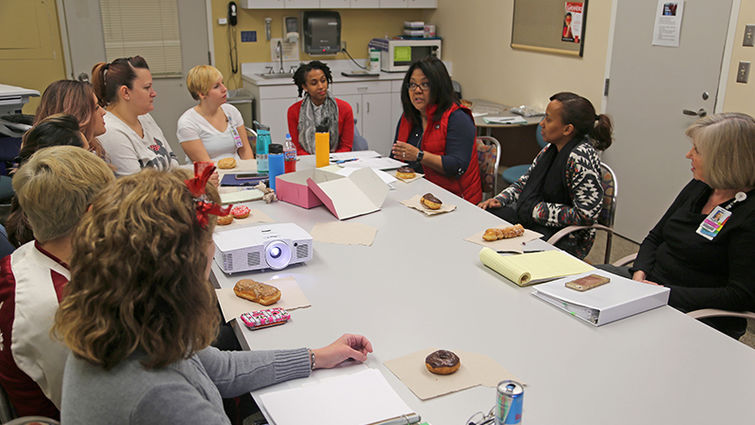
At the monthly professional governance committee of the OB nursing staff, nurses discuss ways to improve patient care. Holly Yelorda, Magnet® coordinator, is fourth from right.
The flagship hospitals of Loma Linda University Medical Center—the adult hospital and Children’s Hospital—are embarking on a journey of excellence designed to improve patient outcomes, elevate nursing practice, and attract and retain the finest nursing staff available.
Holly Yelorda, Magnet® coordinator, says the journey extends several principles and ideas that have played integral roles in patient care in the past into the 21st century.
“At LLUMC, we strive for the core values of compassion, integrity, excellence, teamwork, and wholeness in the way we treat our patients and the way we work in our community,” Yelorda observes. “Historically we’ve done this through innovations in cancer treatment, cardiac care, proton therapy, and research. Nursing is a discipline that is also striving for excellence in practice.”
She goes on to explain that, “the Magnet® philosophy aligns with our core values. It is all about empowering nurses to come up with innovative treatments and interventions for their patients; it’s about collaboration with other interdisciplinary providers to assure that our patients receive the best care across the continuum; and it’s about nurse-to-nurse teamwork to make sure the workplace environment is healthy. It promotes positive relationships and lifelong learning.”
Inspired by the Magnet Recognition Program® of the American Nurses Credentialing Center, the journey advances three goals within health care organizations:
· To promote quality in a setting that supports professional practice
· To identify excellence in the delivery of nursing services to patients
· To disseminate best practices in nursing services.
More information about the program is available online at:
https://www.nursingworld.org/organizational-programs/magnet/
According to Yelorda the concept of the journey to excellence came about after a nurse by the name of Margaret McClure began to look at why some hospitals had difficulty retaining staff while others did not.
“Under the American Academy of Nursing, McClure conducted her study in the early 1980s,” Yelorda notes, “during a severe nursing shortage in the United States. She discovered 14 distinct characteristics that allow hospitals to attract and retain staff. Over the next few years, these characteristics became known as the 14 forces of magnetism.”
The 14 forces were later formalized into the Magnet® program and broken down into five main components:
· Transformational leadership
· Structural empowerment
· Exemplary professional practice
· New knowledge, innovations, and improvements
· Empirical outcomes
“The Magnet® designation represents the highest distinction given to an organization for excellence in nursing,” Yelorda reports. “While we focus on the Magnet® goal, we want our nursing staff to concentrate their efforts on the individual actions necessary to bring our practice to the highest levels of excellence. Nationally, there are only 300 hospitals with Magnet® designation. In California, there are 31.”
Yelorda adds that organizations typically fall into one of two categories in terms of how they pursue the goal. The first is to implement the programs and procedures that successful Magnet® hospitals employ. The second is to make a big announcement that the organization is going to pursue Magnet® certification and make that the goal. She says the first is the better approach.
“Magnet® is not primarily about achieving a distinction or getting a reward,” she says. “It’s about transforming patient practice, improving outcomes, and creating an atmosphere where nurses want to work, where they’re proud to work.”
Yelorda believes that focusing on the goals of the Magnet® program will produce improved outcomes for patients, nurses, and the organization itself. She adds that Loma Linda nurses deserve far more recognition than they get for a number of ways in which they seek to develop and implement best practices in patient care. She points to recent innovations that have come through the shared governance program and other channels as evidence of exemplary professional practice.
“Our nurses have impact on not only the hospitals they serve, but also the communities we live in,” she states. “We are working to provide opportunities for our nurses to increase in skill and expertise. We want to make sure that the people at the bedside are empowered to make change. They are the ones coming up with the innovations.”
She adds that her office will be releasing more information about the journey of excellence throughout 2017, but for now, embarking on the journey to excellence will lead to substantial gains.
“This is a journey towards improving patient outcomes,” she insists. “We will focus on the process and changing the organizational culture to align with the concepts of excellence. We want to do everything we can to make this a place where patients love to come and people love to work.”
